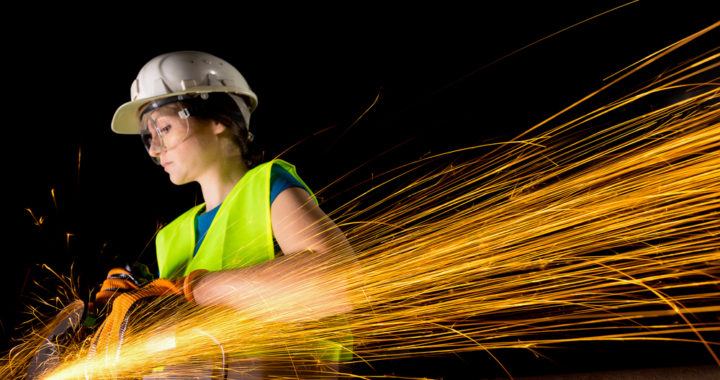
Making The Industry More Welcoming For Women Ironworkers
Right now, the steel and construction industries are in a labor shortage that hasn’t been seen in quite some time. Making this even more difficult is the fact that there is no shortage of projects to do. However, with steel structures getting more and more complex, there’s a need for more people to do the work.
There are a few reasons for this shortage. First, people are retiring faster than new workers can fill their place. Another major contributor that doesn’t get discussed is the lack of women ironworkers in the industry. Women make up only 10% of all construction workers, and the percentage of women in steel is even lower. Like law enforcement, similar male-dominated industries have made steps to bridge the gender gap, but steel still has a long way to go. So, with this in mind, here’s where the steel industry can begin to create a more inviting atmosphere for women ironworkers.
Education
Many of the barriers to women ironworkers are established before they ever start looking at the want ads for steel companies. From a young age, it needs to be clearly laid out that there are opportunities for long-term developments in the industry. This will play a large role in more women pursuing academic subjects and apprenticeships that will help them find their way in the steel industry. What can companies do? A lot of this is doing your part to promote these types of programs. For example, webinars, seminars, and local associations are good launchpads for women to fully understand the steel industry and what it has to offer.
For example, while many automatically associate ironworkers with fieldwork, there are many positions in office and design settings as well. Capable women can work in any of these three areas. However, it’s important to be aware that all of them exist before deciding to enter the industry or not.
Photo by goodluz
Mentorship
Piggybacking off of this, a great way to make women ironworkers feel more welcome in the industry is to make sure they have a comprehensive mentorship network available. This applies to any new workers but can be incredibly valuable for women dealing with discrimination or simply having a harder time integrating themselves. Consider a few senior staff members who can help your new hires with the technical aspects of the job and how to socially navigate the workplace.
Creating A Safe, Accepting Environment
One leg up that the steel and construction industries have over some other male-dominated fields is that the pay gap isn’t necessarily as wide. This helps address one of the biggest issues for women trying to break into new industries (though work still needs to be done, though). However, other concerns may ward women ironworkers off, from increased harassment to disproportionate criticism of their work. The perception of steelwork as a macho, male-dominated industry has warded off many a potential hire.
A lot of this is going to require you to address issues like bias in your current staff. It’s a good idea to see if sensitivity training will be useful, especially in management. Also, make sure you have a proper HR pipeline to quickly process and respond to these types of complaints.
Photo by Myroslava Malovana
Elevating Existing Women
Hiring more women ironworkers and creating a good environment for them is a good start. But if you want to retain them, you need to show a clear path to career advancements. As a result, you must take a look at existing women on staff and make sure they are getting fair consideration when it comes to leadership positions. Not only do they bring the benefit of a diverse perspective, but it’s an instant draw to women ironworkers who also want to advance in the industry. Your company needs to show that anyone can advance based on merit, not simply having the confidence or connection to ask for that promotion.
Providing Proper Gear and Equipment
Because women ironworkers have been so rare for so long, it’s rarely discussed whether or not they have the tools, gear, and equipment to properly do their job. To be fair, for the most part, items like steel fabrication software and heavy machinery are gender-neutral. As long as someone has the proper qualifications, they can use it in the same manner. However, there are some side-elements that may need to be catered to women ironworkers, such as women’s ironworker boots and women’s ironworker pants. Specific gear, PPE, and clothing in women’s sizes are few and far between, so companies will need to direct their new hires to where they can make purchases for their overall benefit. 
Photo by Chatchai.wa
Tech Improvement
The labor crisis in ironworking and construction, in general, is causing more and more companies to try to look inward on their practices. Part of this is some of their policies and practices actively hindering the ability to hire female ironworkers. But another element of this is getting more eyes on the construction industry in general. Typically, in the minds of the younger generation, construction is seen as a bit of a “dinosaur” industry, sticking with legacy systems and practices to the detriment of efficiency and progress.
As a result, for ironworkers recruiting women, it’s not just enough to be welcoming, but one also needs to be modernizing. This means using technology where it’s a baseline, but in other areas that could improve operations. Project management software like eSUB is the perfect example. Investing in tech like this helps the bottom line by calculating bids and actuals. However, it also makes it easier for ironworkers to do their jobs by providing tools like cloud storage for information and the ability to quickly record equipment location and usage.






